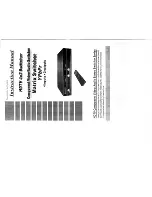
Chapter 4. Making Connections
1. Insert the SFP transceiver into one of the four switch module bays. There’s only one orientation that
the module can be plugged. The optical connector should face outward. The slot connector should
face down for the upper bays, and up for the lower bays.
2. Slide the module into the slot and press firmly to ensure it seats into place.
Note: When a SFP port is used, its correspondent 10/100/1000BASE-T port is automaticaly disabled.
Note: Installing or removing a SFP module can be done without powering off the switch. SFP
transceivers are hot-swappable, but make sure there are no network optic cables connected to the
module before removing it!
The SFP modules that can be used with DmSwitch and each correspondent maximum cable lenght are
described in the table bellow:
Table 4-2. Gigabit SFP Modules
SFP Module
Fiber Type
Maximum Lenght
1000BASE-SX
multimode
550m
1000BASE-LX
singlemode
10km
1000BASE-LH
singlemode
70km
1000BASE-LZ
singlemode
110km
Warning
Signals over fiber optic cables are transmitted via lasers. Although the lasers are
compliant with the requirements of Class 1 Laser Products and are eye safe in
normal conditions, never look direclty at a transmit port when it’s turned on!
4.3. Connecting the Switch in a Stack Configuration
DmSwitch 3000 family supports two stacking topology configurations, the line and the ring topologies
and up to 8 equipments. In line-topology, there’s one cable connecting each switch to its neighbour. In
ring-topology, a redundant path is formed by an extra cable connecting the bottom switch to the top switch
of the stack.
Stacking connections should be made using 27 and 28 10/100/1000Base-T ports only and category 5 or
better UTP/STP cables.
20










































